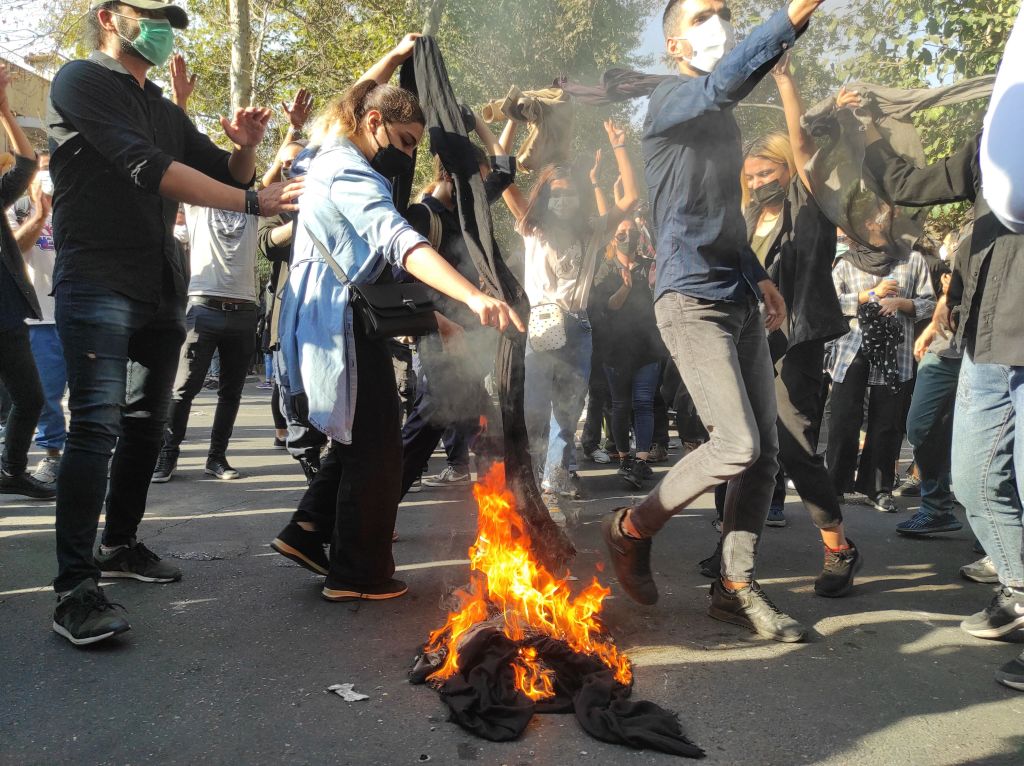Mandatory veiling may be the law of the land, but at the heart of the women’s movement in Iran lies the confidence that rules are made to be rewritten.

The room thunders with applause as her name is announced over the loudspeaker.
Onlookers cheer her on as she approaches the stage to receive her award for “Distinguished Doctor.” The awe in the room is palpable as her accomplishments in the medical field flash on a projector screen. It turns out she is also a seasoned mountaineer, which elicits whistles from the crowd. In her sleek sky-blue pantsuit and heels, Fatemeh Rajaei-Rad looks as distinguished as her newly bequeathed title indicates.
But it was her multi-hued scarf that attracted the most attention during the awards ceremony on Oct. 24. All because she had wrapped it around her neck instead of on her hair.
In Iran, where Dr. Rajaei-Rad lives, hijab laws mandate women to cover their hair in public. “Improper veiling” can have harsh consequences if one runs into the so-called morality police. Last year, 22-year-old Mahsa Amini fell victim to them for allegedly violating the dress code and died while in custody under suspicious circumstances.
Her death sparked a nationwide uprising in which thousands of women took to the streets to protest longstanding inequality. Their rallying call, “Woman, Life, Freedom,” struck a chord worldwide.
Now, more than a year later, women are defying compulsory hijab on an unprecedented level, most often at significant risk to their lives and livelihoods. Dr. Rajaei-Rad is one of them.
The footage of her receiving the award with her hair uncovered went viral, and two days after the ceremony, her medical license was revoked. The authorities did not leave it at that. They summoned the event planners to a correction facility for interrogation and ousted the president of Imam Khomeini Hospital in Amol, where Dr. Rajaei-Rad was employed.
The repercussions reached a point where the young doctor was compelled to make a public apology, fully covered this time, for “having offended anyone.” Whether she has succeeded in reclaiming her license remains unclear.
Think about it: A girl who spends years studying and working hard to get into medical school finally achieves her dream and succeeds in her field to earn the title of “Distinguished Doctor,” only to be stripped of her credentials.
For showing her hair.
It was far from an isolated case. Earlier that month in Tehran, teenager Armita Geravand was embarking on the metro on her way to school when two female police guards started harassing her. Like Rajaei-Rad, she had appeared without a headscarf. An altercation ensued, which led to Geravand sustaining head trauma, losing consciousness and falling into a coma. Pronounced brain-dead on Oct. 22 after being held in an intensive care unit for several weeks, she died on Oct. 28.
Such incidents have driven Iranian women to protest the hijab laws by appearing in public with their hair uncovered and engaging in symbolic acts such as setting headscarves on fire. Blossoms of bravery are sprouting across the land on an unprecedented scale. Yet, like Rajaei-Rad, they are all too often cut off at the stem before reaching full bloom.

Her story hits close to me, because her hometown of Amol is also where my mother is from. It was where I attended a private high school with gifted students from prominent families. Many of my classmates aspired to pursue medical careers, meaning they had to enter the rigorous natural sciences track as sophomores. It also felt like the right track for me, and I even succeeded in becoming valedictorian one year. However, as graduation came and went, I had lingering doubts about the direction I was headed. As bright as the prospects were, something about the overarching context felt off.
It was as if I could sense the cognitive dissonance of being a high-achieving female doctor subject to archaic rules and regulations in our society. One of my former classmates is now an eminent pediatrician in Amol. Despite having a strong social media presence, she sports a covering in all her photos—because regardless of how she feels about the hijab, to do otherwise would put her career at risk. Another friend and classmate immigrated to the U.S. after completing her studies in Iran and now enjoys a successful career in pharmacy on the West Coast. I am aware she traveled to Iran last year to attend her father’s funeral. As she is married to a fellow Iranian, she will have needed her husband’s legal permission to leave the country upon returning to the U.S.
It seemed that everywhere I went, women were openly defying the dress code by refusing to wear headscarves—on the street, in stores, in cafes, on public transportation, in the mountains, by the sea, while driving.
When I was living in Iran at the time, it was almost unthinkable for women to demonstrate resistance against compulsory hijab for fear of retribution. But today, 44 years after living under a theocratic regime bent on classifying them as second-class citizens, they are finally saying enough is enough.
In the words of Narges Mohammadi, imprisoned Iranian human rights activist and this year’s Nobel Peace Prize Laureate, “The image that the tyrannical government portrays of the Iranian people and society does not match the lively, dynamic, tolerant and considerate culture of the Iranian people and society.”
Evidence of the feminist movement was palpable during my recent stay in Iran. It seemed that everywhere I went, women were openly defying the dress code by refusing to wear headscarves—on the street, in stores, in cafes, on public transportation, in the mountains, by the sea, while driving. Almost as many women were going about with their hair uncovered as those who opted for veiling. Everyone seemed okay with the arrangement and respectful of one another’s choices, including the men. It reflected how the populace—religious or secular, male or female—opposed not the hijab per se, but the eradication of choice.
As the movement gained momentum, the authorities started unleashing their counterattacks. Billboards and posters popped up around town with slogans extolling the virtues of chastity or promoting veiling as a religious mandate. Police and volunteers would issue verbal warnings in subways, airports, and other public spaces. On at least several occasions as I was walking around town—especially in the late afternoons and evenings when more people were out and about—hordes of female officers, all in a single file and covered in black from head to toe, would call out women passersby for dressing immodestly. They reprimanded me once for wearing a skirt that revealed my ankles. The next day, I stood in front of a hijab poster close to where the incident had occurred with my hair uncovered, took a selfie, and posted it on my Instagram page in a small act of vengeance.
It seemed like the more they engaged in civil disobedience, the more the authorities implemented every tactic in the book to instill fear and make it clear that compulsory hijab was alive and well.
Businesses serving women not wearing the hijab were targeted. One day, I heard that a high-end pastry shop in a neighboring city was shut down for its leniency towards women’s dress codes. While on a spring trip with a tour group to the ancient city of Kashan for its annual rose water festival, I couldn’t help noticing the signs on almost every entrance to hotels, restaurants and historical sites emphasizing that the observance of hijab in these places was mandatory. Granted, most of the staff could not care less, and almost half the female visitors flouted the laws.
Women caught without a hijab while driving were at risk of having their vehicles impounded. I’d hear all the time from my female friends and relatives that they or someone they knew had received text messages informing them that because of improper hijab, they could not drive their cars for a designated period: the first time they were caught, the driving ban would be for fifteen days, and the second time for six months. Surveillance cameras installed in various overhead locations on roadways were used to identify “violators.” I remember driving through the main boulevard in town once when my headscarf fell to my shoulders. A girl passing by in the next lane rolled down her window and called out to me that a security camera was ahead. It wasn’t uncommon for women to watch out for one another in those circumstances.
Still, it seemed like the more they engaged in civil disobedience, the more the authorities implemented every tactic in the book to instill fear and make it clear that compulsory hijab was alive and well.
They haven’t stopped targeting Dr. Rajaei-Rad either. A month after revoking her medical license and ousting the president of her workplace, authorities shut down her private practice and expelled her from the board of advisors at a medical university she had been a member of. To add insult to injury, the Supreme Leader’s representative in Amol publicly announced that from then onward, she should wear a chador (a full-length covering for women, leaving only the face visible.)
Seeing what could happen to a female doctor who didn’t play by the book in this environment makes me feel justified in my decision to change the direction I was headed years ago. A lucrative income, prestigious job title, societal recognition and all the perks that come with being in a particular field can never provide a rationale for blatant violations of the rights and freedoms of women within that field.
Mandatory veiling may be the law of the land, but at the heart of the women’s movement in Iran lies the confidence that rules are made to be rewritten. Flames of the feminist revolution have been fanned.
As feminist icon and Ms. founding editor Gloria Steinem affirms, “Using our voices, protesting with our bodies, supporting other women is what the revolution is all about.”
Up next:
U.S. democracy is at a dangerous inflection point—from the demise of abortion rights, to a lack of pay equity and parental leave, to skyrocketing maternal mortality, and attacks on trans health. Left unchecked, these crises will lead to wider gaps in political participation and representation. For 50 years, Ms. has been forging feminist journalism—reporting, rebelling and truth-telling from the front-lines, championing the Equal Rights Amendment, and centering the stories of those most impacted. With all that’s at stake for equality, we are redoubling our commitment for the next 50 years. In turn, we need your help, Support Ms. today with a donation—any amount that is meaningful to you. For as little as $5 each month, you’ll receive the print magazine along with our e-newsletters, action alerts, and invitations to Ms. Studios events and podcasts. We are grateful for your loyalty and ferocity.





